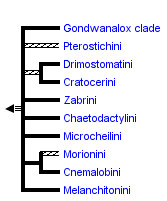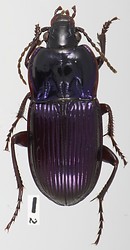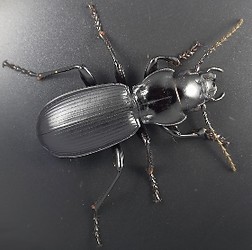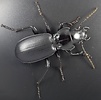pterostichite grade
Kipling Will


This tree diagram shows the relationships between several groups of organisms.
The root of the current tree connects the organisms featured in this tree to their containing group and the rest of the Tree of Life. The basal branching point in the tree represents the ancestor of the other groups in the tree. This ancestor diversified over time into several descendent subgroups, which are represented as internal nodes and terminal taxa to the right.

You can click on the root to travel down the Tree of Life all the way to the root of all Life, and you can click on the names of descendent subgroups to travel up the Tree of Life all the way to individual species.
For more information on ToL tree formatting, please see Interpreting the Tree or Classification. To learn more about phylogenetic trees, please visit our Phylogenetic Biology pages.
close boxIntroduction
Historically these taxa have generally been placed together. Most studies suggest that the included taxa are close relatives, but it is unlikely that this is a monophyletic group relative to other Harpalinae.
Characteristics
There is no clear set of synapomorhies for the group, and so members are Harpalinae that lack the derived features of other groups in the subfamily. Typically, they are medium to large species, very rarely under 4mm in length, often heavy to massively built. Most have two supraorbital setae and a prominently developed and externally visible elytral plica (but there are many exceptions). For most species the female reproductive tract has glabrous gonocoxites or gonocoxites that have relatively few rather large setae.
Discussion of Phylogenetic Relationships
As noted above this is not likely a monophyletic group, and there is no clear, prefered set of relationships among its members. Cnemalobini is probably related to some or all Morionini (Roig-Juñent & Flores 1995; Liebherr & Will 1998), and some structures of the female reproductive tract and external morphology suggest Chaetodactylini are likely to be related to Morionini (Will 2003) as well. However, other structures of the female reproductive tract suggest that Chaetodactylini and Michrocheilini may be sister-taxa, though the external morphology is strikingly different in the two groups. Drimostomatini + Cratocerini probably form a clade, and this could be sister to the Gondwanalox clade. Melanchitonini and Zabrini are likely to be related to taxa within Pterostichini, which probably is a grade rather than a clade, in Harpalinae.
Title Illustrations

| Scientific Name | Myas coracinus |
|---|---|
| Identified By | K.Will |
| Life Cycle Stage | Adult |
| Image Use |
 This media file is licensed under the Creative Commons Attribution License - Version 3.0. This media file is licensed under the Creative Commons Attribution License - Version 3.0.
|
| Copyright |
© Kipling Will

|
| Scientific Name | Pterostichus (Hypherpes) lama |
|---|---|
| Location | California, Sierra Co. |
| Comments | Image taken by A. Seago |
| Specimen Condition | Live Specimen |
| Identified By | Kipling Will |
| Sex | Male |
| Life Cycle Stage | Adult |
| View | Dorsal |
| Image Use |
 This media file is licensed under the Creative Commons Attribution License - Version 3.0. This media file is licensed under the Creative Commons Attribution License - Version 3.0.
|
| Copyright |
© Kipling Will

|
| Scientific Name | Abropus carnifex |
|---|---|
| Specimen Condition | Dead Specimen |
| Identified By | K.Will |
| Life Cycle Stage | Adult |
| Image Use |
 This media file is licensed under the Creative Commons Attribution License - Version 3.0. This media file is licensed under the Creative Commons Attribution License - Version 3.0.
|
| Copyright |
© Kipling Will

|
About This Page
Kipling Will

University of California, Berkeley, California, USA
Correspondence regarding this page should be directed to Kipling Will at
Page copyright © 2006 Kipling Will
 Page: Tree of Life
pterostichite grade.
Authored by
Kipling Will.
The TEXT of this page is licensed under the
Creative Commons Attribution License - Version 3.0. Note that images and other media
featured on this page are each governed by their own license, and they may or may not be available
for reuse. Click on an image or a media link to access the media data window, which provides the
relevant licensing information. For the general terms and conditions of ToL material reuse and
redistribution, please see the Tree of Life Copyright
Policies.
Page: Tree of Life
pterostichite grade.
Authored by
Kipling Will.
The TEXT of this page is licensed under the
Creative Commons Attribution License - Version 3.0. Note that images and other media
featured on this page are each governed by their own license, and they may or may not be available
for reuse. Click on an image or a media link to access the media data window, which provides the
relevant licensing information. For the general terms and conditions of ToL material reuse and
redistribution, please see the Tree of Life Copyright
Policies.
- First online 07 July 2006
- Content changed 07 July 2006
Citing this page:
Will, Kipling. 2006. pterostichite grade. Version 07 July 2006 (under construction). http://tolweb.org/pterostichite_grade/51493/2006.07.07 in The Tree of Life Web Project, http://tolweb.org/











 Go to quick links
Go to quick search
Go to navigation for this section of the ToL site
Go to detailed links for the ToL site
Go to quick links
Go to quick search
Go to navigation for this section of the ToL site
Go to detailed links for the ToL site